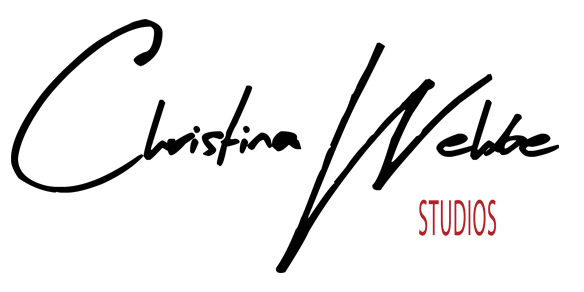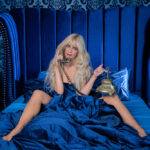
by ChristinaWehbe | Jan 12, 2025 | Boudoir, For Photographers
The Photographer’s Business Plan Course
This self-paced program is designed exclusively for boudoir photographers looking to build a thriving, profitable business. It covers everything you need to succeed: from branding, marketing, and advertising strategies to mastering creative lighting and corrective posing techniques. Whether you’re just starting out or looking to elevate your business, this course gives you the tools and confidence to create a brand that attracts clients, books consistently, and delivers unforgettable results.
What You’ll Learn
In this course, you’ll gain the skills and strategies to:
- Build a Photography Business: Master the art and business of photography with proven frameworks and blueprint.
- Launch and Optimize Websites and Sales Pages: Create a professional, SEO-friendly site that converts visitors into clients.
- Master Online and Offline Marketing: Learn how to promote your business effectively through social media, ads, email, and local networking including public speaking projects.
- Run Successful Ad Campaigns: Develop and launch successful ads on platforms like Facebook, Instagram, and TikTok to attract and book your ideal clients.
- Organize Seamless Photoshoots: Implement repeatable systems for lighting, posing, and client communication to deliver consistent results.
- Connect with Other Photographers: Join a supportive community of boudoir photographers who share your journey and inspire your growth.
Bonus for Members: As a course member, you’ll gain one-time complimentary access to our Three-Day Boudoir Photography Workshop ($2800 value!)
Exclusive Tools and Resources
- 50 PSD Actions: Streamline your editing process with 40 professionally crafted PSD actions designed to save you time and enhance your workflow. The actions include airbrush and skin smoothing actions, eyes and teeth whitening, contouring and highlighting and many other essential tools to create magazine quality images. ($500 value)
- Customizable Boudoir Preparation Guide Template: Personalize this guide with your own photos and branding. It comes complete with professionally written text and copy, offering a polished resource for your clients. ($150 value)
- Customizable Boudoir Lingerie Guide Template: Create a stunning, branded lingerie guide tailored to your studio. This template includes expertly crafted text and space for your own imagery, ensuring a cohesive and professional presentation. ($150 value)
- Over 50 Pages of Combined Templates: Both the Boudoir Preparation Guide and Lingerie Guide templates are packed with value—over 30 pages combined! Plus, you’ll receive our pricing templates, marketing material templates, all full with text and all you have to do is add your logo and your own images. You’ll receive all the future updates to keep your guides fresh and relevant. These are the exact resources Christina uses for her studio’s clients.($750 value)
- The Boudoir Contract Bundle is your ultimate business safeguard, offering customizable contracts, model releases, and essential documents tailored for boudoir photographers. Protect yourself and your clients while elevating your professional image with this comprehensive collection. ($150 value)
- Lighting and Studio Setup Guidance: Receive detailed, step-by-step instructions on creating effective lighting setups and designing a functional studio space tailored to your specific needs.
- Gain lifetime access to a private community of supportive photographers who share your journey, offering guidance, inspiration, and a network to help you grow both creatively and professionally. Together, you’ll navigate challenges, celebrate wins, and elevate your boudoir photography to new heights.
Why This Course Works
The Photographer’s Business Plan isn’t just another photography course. It’s a step-by-step guide designed by a seasoned photographer who’s built and scaled multiple successful studios. You’ll get actionable advice, repeatable systems, and personalized support to help you achieve your goals.
Who This Course Is For
This course is perfect for:
- Beginner photographers ready to start their business with confidence.
- Experienced portrait Photographers looking to refine their marketing, advertising, lighting, posing and business strategies.
- Boudoir Photographers who want to master the business side of boudoir photography in addition to posing, lighting, and creating unforgettable client experiences.
Bonus for Members: As a course member, you’ll gain one-time complimentary access to our Three-Day Boudoir Photography Workshop ($2800 value!)
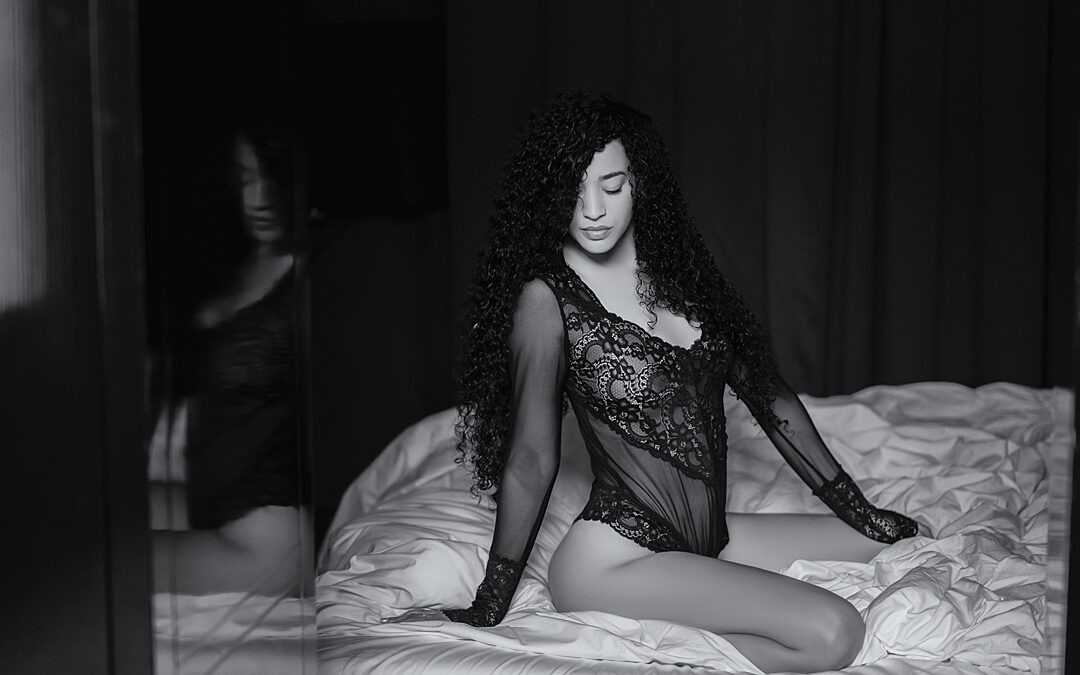
by ChristinaWehbe | Jan 2, 2025 | Boudoir, For Photographers
The Art of Black and White Monochromatic Boudoir Portraits
There’s something undeniably timeless about black-and-white boudoir portraits. By stripping away color, these images focus on the play of light and shadow, the delicate textures of lace or skin, and the raw emotions captured in a single moment. This cinematic style invites you into a world of elegance and intimacy—where every detail tells a story and every shadow whispers allure.
Monochromatic boudoir photography isn’t just a technique; it’s an art form that elevates the emotional and visual impact of every image. In this post, we’ll explore the beauty of black-and-white portraits through four breathtaking examples that showcase how light, contrast, and reflection can transform boudoir photography into iconic, timeless art.
1. The Gentle Embrace of Light and Shadow
In the first image, the model sits gracefully on a bed, draped in a delicate lace bodysuit. Soft, natural light caresses her figure, accentuating her curves and casting intricate shadows that bring the photograph to life. A subtle reflection on the left side of the frame creates a mesmerizing double-image effect, adding depth and an almost ethereal quality to the portrait.
The absence of color allows the lace’s intricate patterns to take center stage, making the texture even more captivating. The interplay of light and reflection pulls the viewer into a quiet, dreamlike moment, highlighting how black-and-white photography transforms simplicity into sophistication. It’s not just a portrait; it’s a story told in light and shadow.
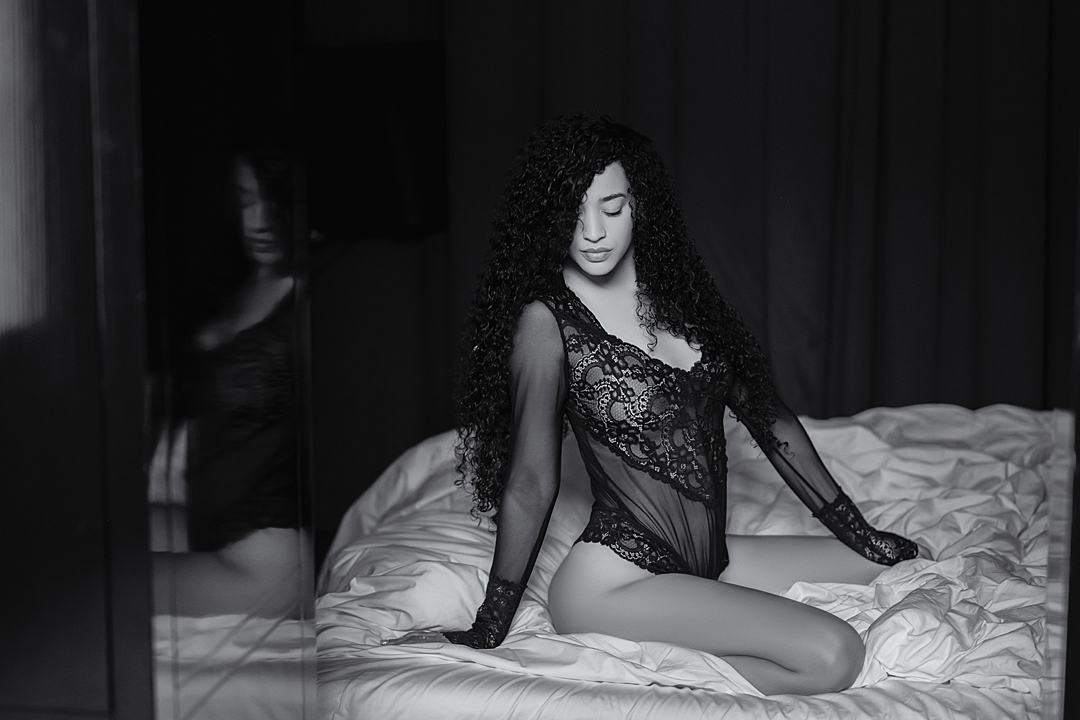
2. Reflection and Sensuality in Monochrome
In this image, the model sits with her back slightly turned toward the viewer, one arm gently crossing her body in a pose that feels intimate and self-embracing. The monochromatic palette draws attention to her serene expression and the natural texture of her curly hair, which frames her face with effortless elegance.
What makes this shot truly captivating is the use of reflections on either side of the frame. These subtle, blurred reflections add a layered depth, creating a sense of mystery and intrigue. The reflective surfaces act like a frame within a frame, pulling the viewer closer, as though they’re catching a fleeting glimpse into a private moment. It’s a beautiful example of how black-and-white boudoir photography can evoke sensuality with quiet sophistication, focusing on form, line, and light to tell a story that’s both alluring and timeless.
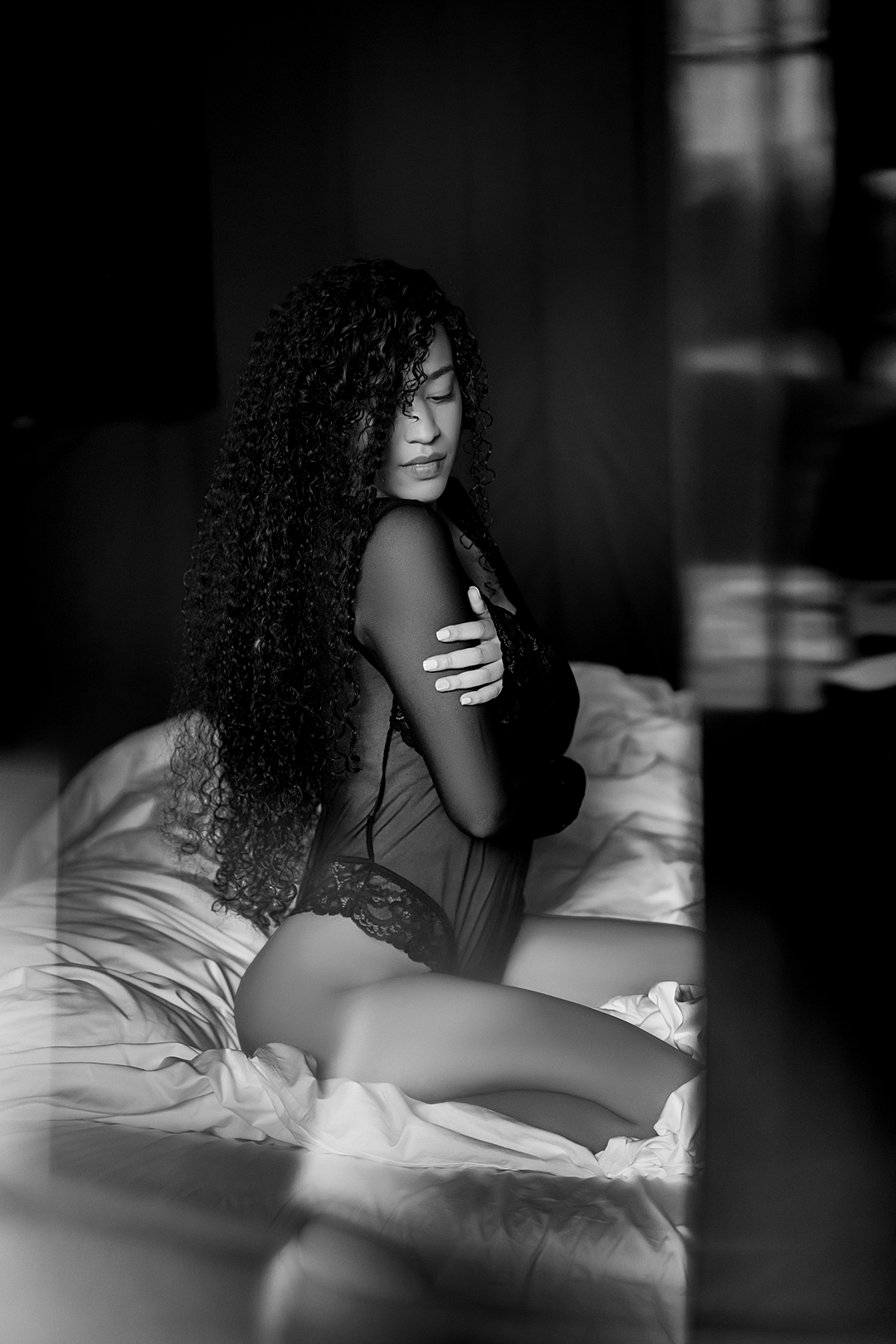
3. The Power of Movement in Monochrome
The third portrait captures the model arching her back gracefully, her face tilted up as if lost in a moment of personal bliss. Her long, flowing hair cascades behind her, adding a dynamic sense of movement to the otherwise still setting. In monochrome, this movement becomes even more pronounced, with the lighting bringing out the details in her hair and the texture of the bedspread.
In the background, a faint reflection softens the overall composition, hinting at the mirror without distracting from the central figure. The contrast between the dark lace bodysuit and the white sheets emphasizes the curves of her body, guiding the viewer’s eye along her form. This image showcases how black and white boudoir can be both bold and delicate, capturing raw emotion and refined elegance simultaneously.
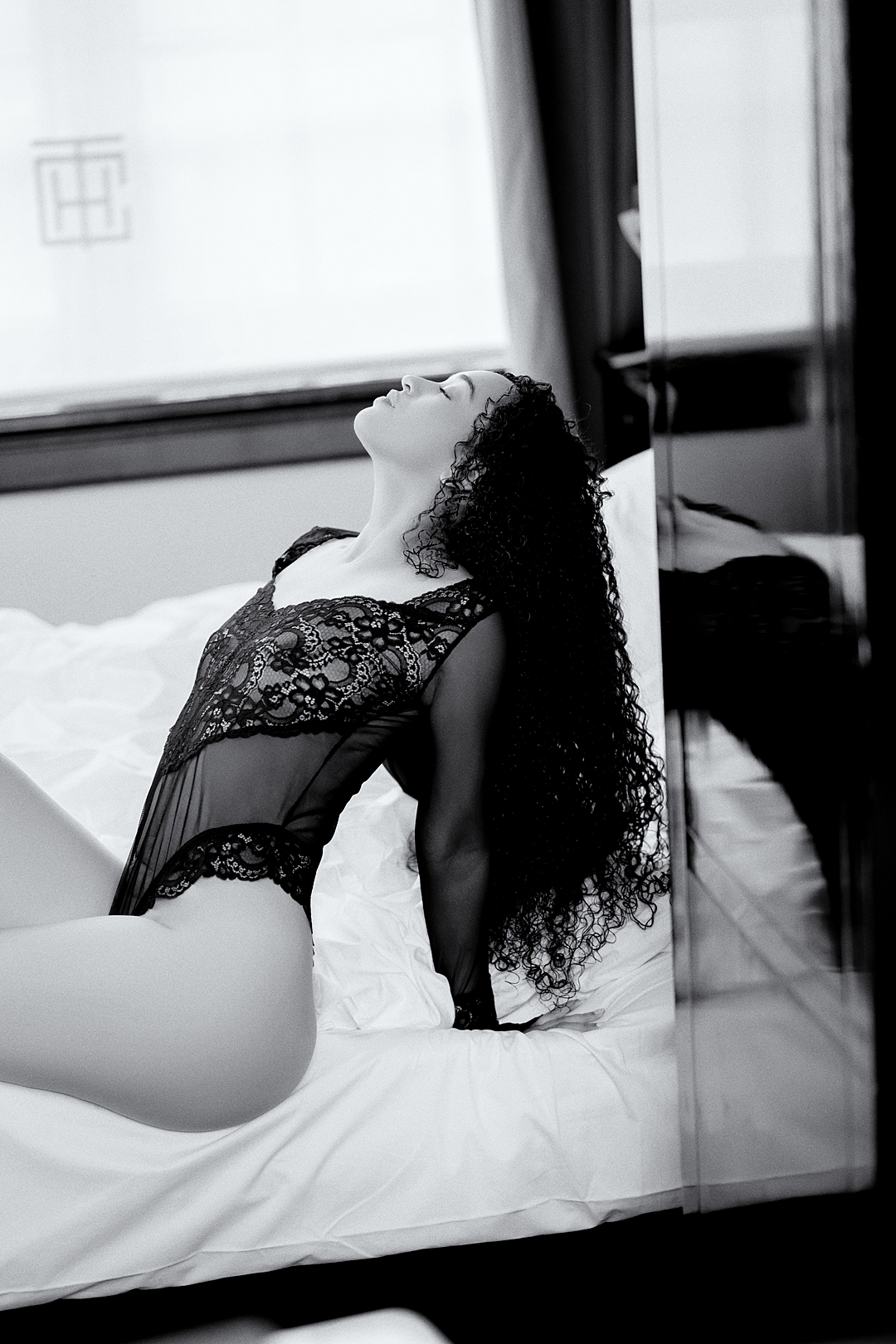
4. The Quiet Intensity of a Gaze
In the final image, the model lies on the bed with her eyes closed, her head resting gently on her hand. The focus here is on her expression and the quiet intensity of the moment. The reflection in the background is soft and blurred, adding depth without detracting from the model’s peaceful pose.
The monochromatic approach highlights the contrast between her dark curls and the lightness of the bed linens, allowing her serene expression to take center stage. This photo captures a softer, more introspective side of boudoir photography, using the black-and-white palette to create a mood that is both calming and compelling. The reflection creates a subtle sense of duality, as if capturing both the outer beauty and inner calm of the subject.
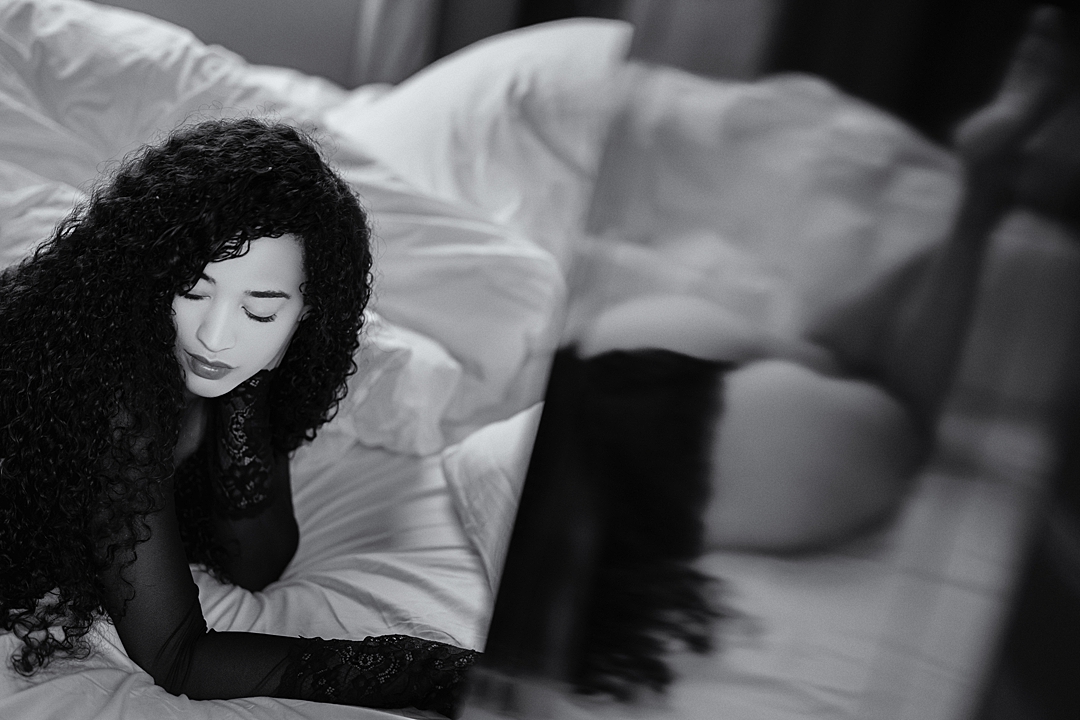
Why Monochromatic Boudoir Photography Works
Monochromatic boudoir photography enhances the emotional impact of an image by focusing on the interplay of light and shadow. Without the influence of color, textures, forms, and reflections become more pronounced. This can create a mood that is both intimate and powerful, perfect for boudoir photography, where subtlety is key.
In these portraits, the reflections add complexity, inviting viewers to experience the scene from different perspectives. The monochromatic palette also brings out the intricacies in lace, curls, and expressions, elevating the storytelling in each shot. Black and white boudoir photography allows photographers to connect with viewers on a more emotional level, creating timeless images that transcend the typical boudoir experience.
Tips for Monochromatic Boudoir Photographers
- Play with Light and Shadow: Lighting is critical in black-and-white photography. Experiment with different lighting setups to create depth and emphasize textures.
- Use Reflections: Mirrors and reflective surfaces can add layers to your composition, giving the portrait more dimension and interest.
- Focus on Textures: In monochrome, textures like lace, hair, and fabrics become more prominent. Use these to create focal points in your images.
- Encourage Natural Poses: For boudoir, poses that feel natural and unposed often come across as more intimate and authentic.
Monochromatic boudoir photography offers a unique way to explore sensuality and elegance. By focusing on form, light, and emotion, monochrome portraits create lasting impressions, telling stories that go beyond what color can convey. If you’re a boudoir photographer looking to add depth and sophistication to your work, black and white monochromatic portraits are a beautiful avenue to explore.
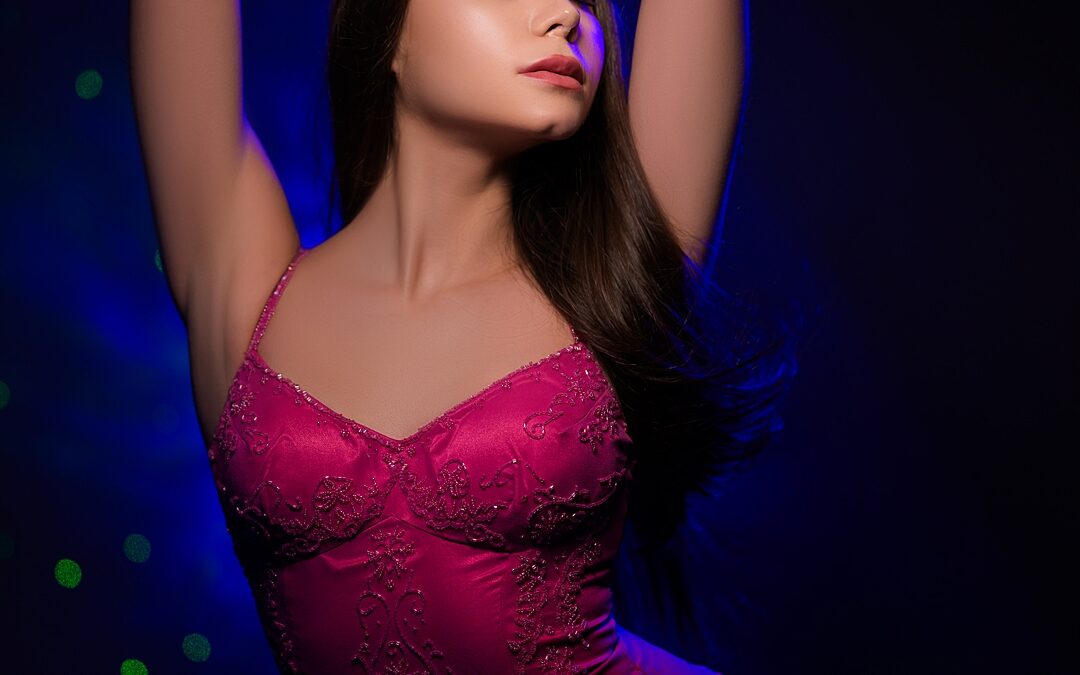
by ChristinaWehbe | Dec 15, 2024 | For Photographers
In portrait photography, one of the most powerful ways to capture both strength and beauty is through dramatic poses. Dramatic poses add intensity, elegance, and a sense of storytelling to your images. But beyond that, they have a unique way of highlighting the many layers of femininity—whether it’s soft and delicate or fierce and bold.
These striking photos featuring expressive, dynamic poses show how drama can create not just beautiful portraits, but ones that capture the complexity of womanhood. Let’s explore how you can master dramatic poses in your portraits while embracing and showcasing femininity in all its forms.
1. The Power of Movement: Fluidity and Grace
Movement is one of the most powerful tools in creating drama, and it’s also deeply connected to femininity. There’s something inherently graceful about the flow of a body in motion—the curve of a back, the tilt of a head, or the sweep of long hair. Incorporating movement into your portraits creates a sense of life and energy, making your subject look powerful and fully engaged.
Take a look at Slava’s portraits, where the flowing hair and strong arm movements add a sense of fluidity and grace. These poses not only highlight her strength but also her softness. In a way, the movement represents the natural flow of femininity—graceful yet full of power. Her hip curving is the epitome of femininity. Encourage your subject to move between poses, allowing them to express themselves through their body language. The result? Photos that feel alive, organic, and deeply feminine.
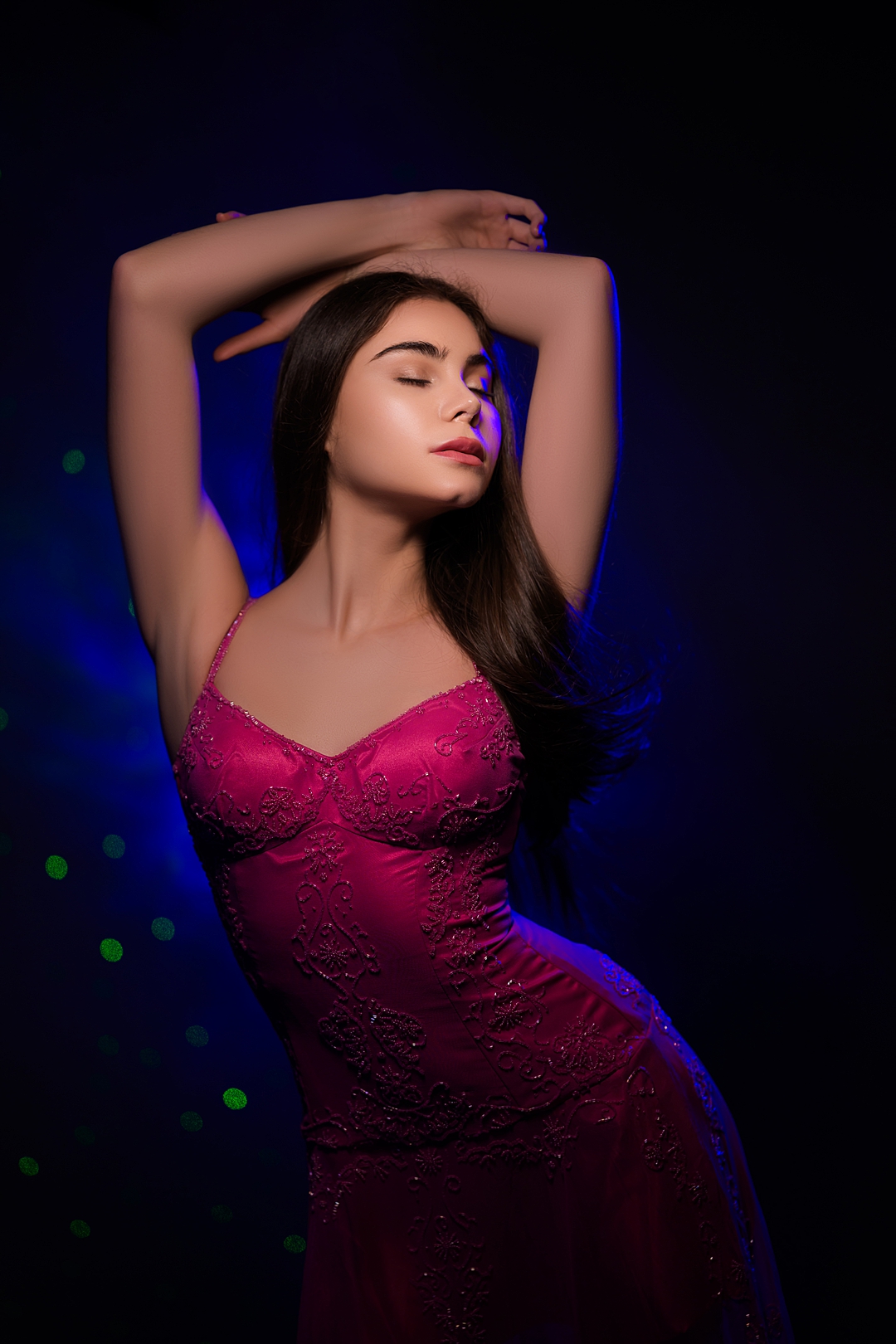
2. Bold Angles: Strength in Femininity
When we think of femininity, we often picture soft, delicate imagery—but there’s so much more. Femininity is also about strength, and bold, angular poses are a perfect way to showcase that in your portraits. Forget about static poses, and embrace the angles that show off the body’s natural curves and lines. A deep arch in the back, a sharp angle in the shoulders, or a high chin instantly adds drama, while still maintaining an element of elegance.
In these portraits, even the slightest change in angle—like the strong posture of an extended arm or the curve of the waist—exudes power. Bold angles represent the resilience and confidence of femininity, reminding us that strength can be beautiful, too.
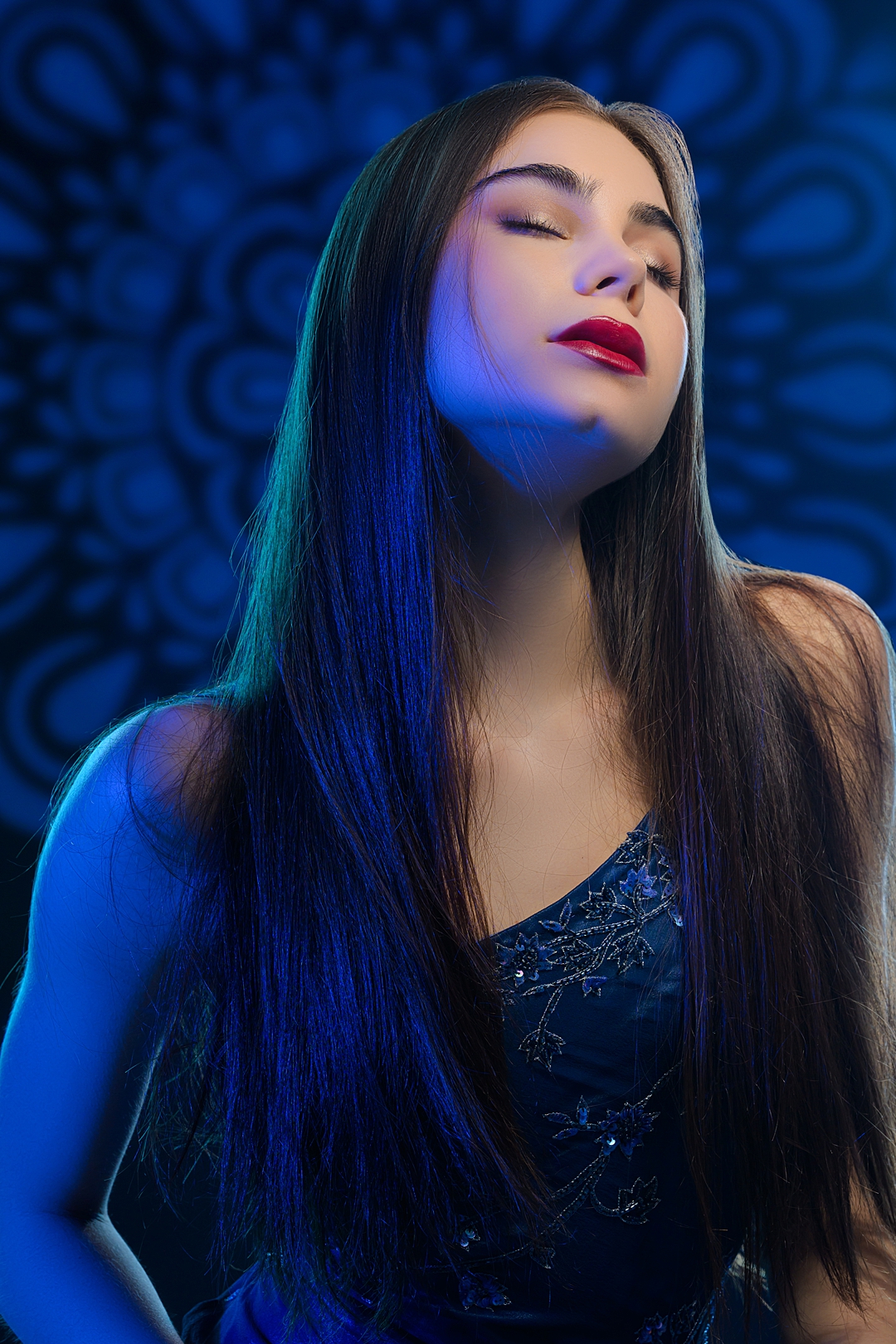
3. Expression Is the Essence of Feminine Power
Drama in portraits isn’t just about how the body moves—facial expression is key in telling the story. Femininity is multifaceted; it can be fierce, soft, sultry, or playful, and dramatic portraits allow these emotions to shine. The beauty of dramatic posing lies in how it gives your subject permission to express emotions beyond the traditional smile.
A powerful gaze or a soft, reflective look can change the entire tone of a photo. In Slava’s portraits, her closed eyes and subtle smile speak of serenity, confidence, and self-awareness—elements deeply tied to feminine power. Whether you’re capturing strength, sensuality, or introspection, encourage your subject to experiment with their facial expressions, pushing past their comfort zone to show the full spectrum of emotions that femininity encompasses.
4. Lighting for Drama: Enhancing Femininity with Light and Shadow
Lighting plays an essential role in creating drama and shaping how femininity is portrayed in a portrait. Dramatic lighting, especially high-contrast setups, can highlight the angles and curves of the body, adding a sense of mystery and depth. Think of lighting as a tool to sculpt your subject—bright highlights that accentuate the features paired with deep shadows that create intrigue.
In these portraits, the bold lighting choices—whether the deep blues or rich pink hues—enhance the femininity of the subject by adding layers of emotion. Lighting becomes an extension of the pose, whether it’s used to create softness or sharpness. Experiment with different lighting techniques to see how they complement the subject’s mood and pose, from soft and ethereal to bold and powerful.
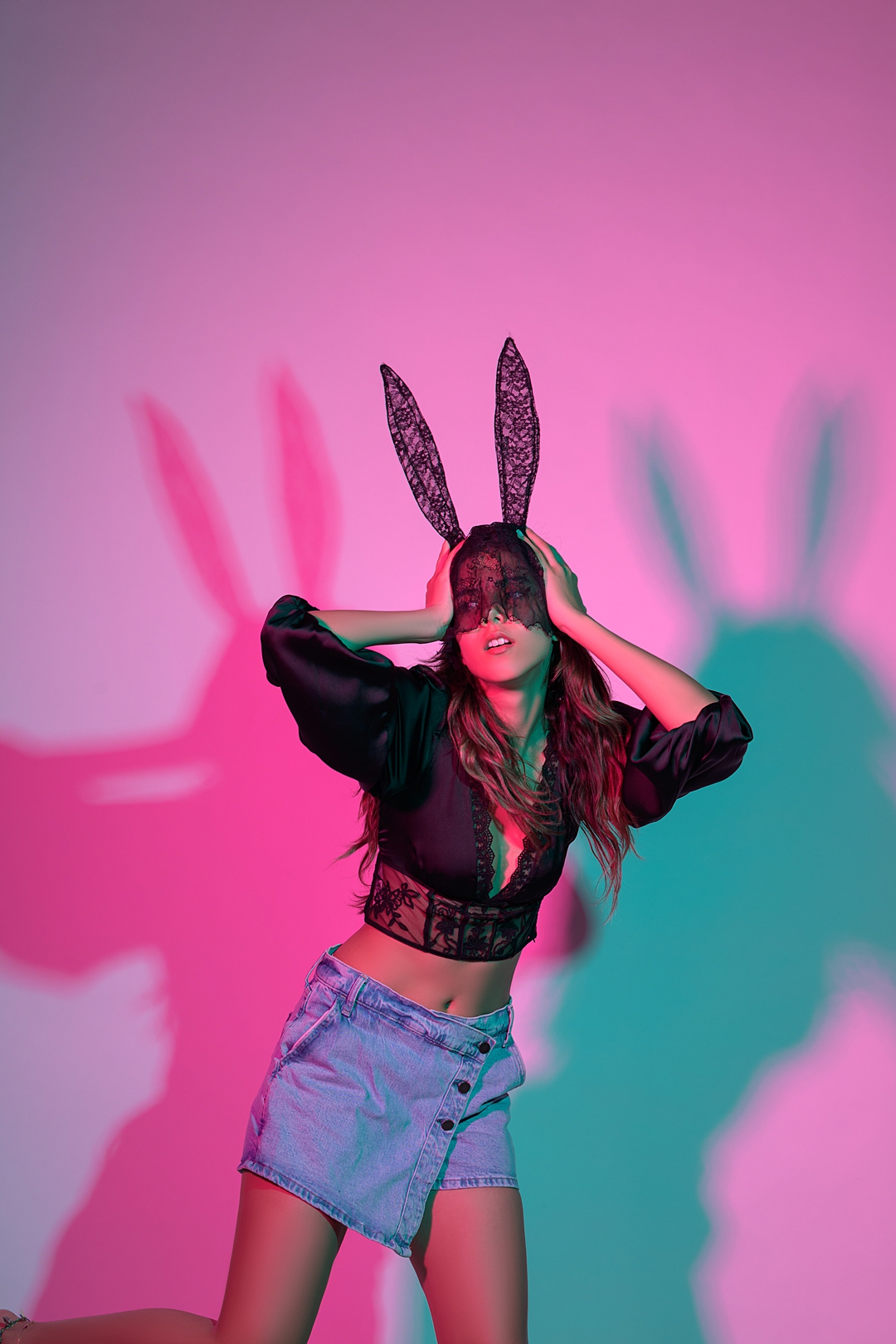
5. Wardrobe: A Celebration of Feminine Drama
Let’s not forget wardrobe—clothing and accessories have a profound way of highlighting feminine strength and elegance. Flowing gowns, detailed fabrics, or bold, structured outfits can amplify the drama of a pose while celebrating femininity in all its forms.
The key is choosing pieces that complement the story you’re telling. In Slava’s portrait with the long gown, the intricate fabric adds texture and glamour, which pairs perfectly with her graceful, confident pose. Whether you’re opting for soft, flowy fabrics that capture movement or something more structured to enhance bold angles, wardrobe plays a crucial role in shaping the overall drama of the shot.
Final Thoughts
Dramatic poses are about embracing both the bold and the delicate sides of femininity, creating portraits that capture the complexity and beauty of your subject. Whether you’re focusing on movement, angles, or facial expressions, dramatic poses allow your subject to express themselves fully—celebrating both their strength and vulnerability.
So, when you’re planning your next portrait shoot, think big! Encourage your subject to tap into their most expressive, confident self, and use poses that capture the wide spectrum of femininity. The result will be portraits that are not only visually stunning but emotionally captivating as well.
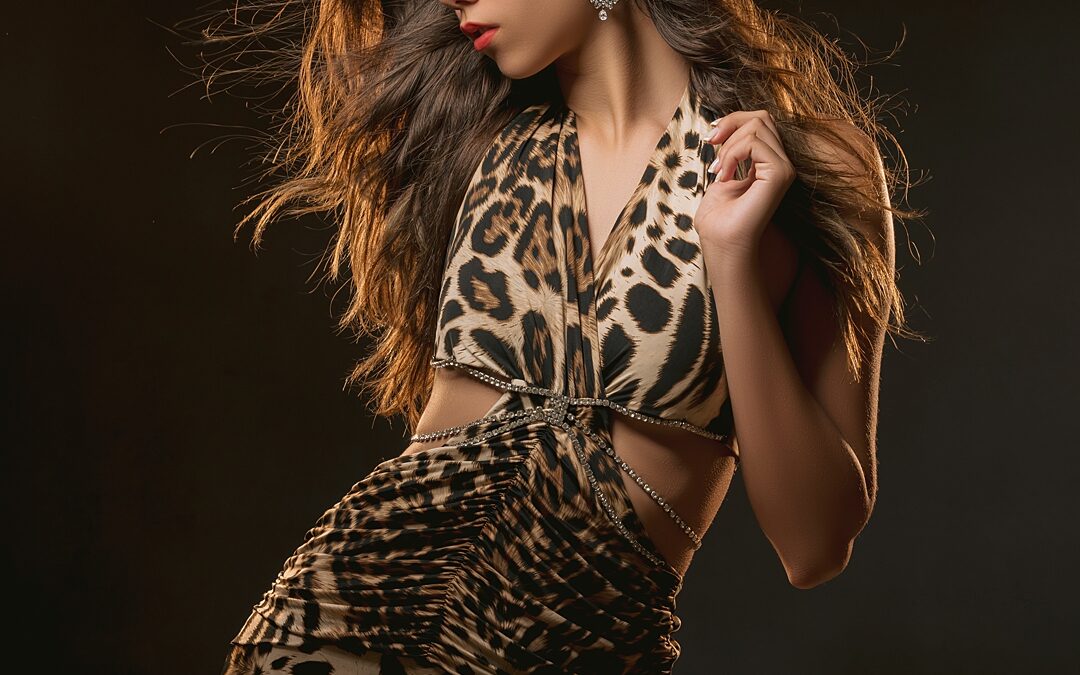
by ChristinaWehbe | Dec 10, 2024 | Boudoir, For Photographers, Portrait Photography
In the world of portrait and boudoir photography, nothing exudes confidence and unapologetic style quite like the bold punch of animal prints paired with wild, untamed hair. If you want your photos to pop with attitude and flair, embrace that full-on mob-wife aesthetic—because let’s face it, winter is here, and it’s time to turn up the heat with fierce, statement-making looks! Then ditch the ordinary and go full throttle with this sassy, unapologetic style. Just look at Diamony, who strut her stuff like a total queen in a recent shoot, slaying every shot in a bold animal print and textured, flowing hair. The vibe? Pure, unfiltered power.
So, why should you unleash the beast in your sessions with animal prints and wild hair? Because these choices aren’t just about fashion—they’re about making a statement. They add that perfect splash of drama, confidence, and a little rebellious spirit that turns heads and dares the viewer to look away. If you’re ready to give your photography a spicy edge, let animal prints and unruly locks lead the way to unforgettable shots.
1. Animal Prints: The Ultimate Power Statement
Animal prints are iconic for a reason—they’re fierce, unapologetic, and full of attitude. Whether it’s leopard, zebra, or tiger stripes, these bold patterns naturally exude confidence and empowerment. When your client slips into an animal-print outfit, it’s like flipping a switch—the energy instantly becomes more daring and adventurous.
In boudoir photography, animal prints can be especially transformative. They bring out the wild side of your client, encouraging them to embrace their inner fierceness and strength. The contrast of such a powerful print against soft, sensual poses creates a unique dynamic that adds layers of depth to your portraits.

2. Wild Hair: Let It Flow!
Forget the sleek, polished look—when it comes to portraits that truly stand out, big, wild hair is where it’s at. Let your subject’s hair flow naturally, allowing it to frame their face with texture and movement. In Diamony’s shoot, her voluminous locks brought a sense of freedom and untamed spirit to the images, complementing the animal-print outfit perfectly.
Wild hair adds drama, texture, and a sense of movement to your shots. It brings a raw, organic vibe that contrasts beautifully with structured poses. Plus, it’s a great way to create dynamic lighting effects, as the texture of the hair catches light in interesting ways, adding more depth to your images.
3. The Psychology Behind Animal Prints and Big Hair
There’s a reason animal prints and wild hair make such a strong impact—they’re deeply tied to how we perceive power, freedom, and rebellion. Animal prints are often associated with strength, confidence, and a primal sense of self. It’s a visual cue that instantly conveys independence and boldness.
Big hair, on the other hand, represents freedom and wildness. When your client lets their hair down—literally—it symbolizes letting go of societal expectations and embracing their natural, authentic self. It’s a visual representation of breaking free from constraints, which is exactly the kind of energy you want in a boudoir or portrait shoot.

4. How to Incorporate These Elements in Your Shoots
If you’re ready to bring the wild side to your photography, here are a few tips for incorporating animal prints and big hair into your sessions:
- Wardrobe Choices: Encourage your client to experiment with bold animal-print outfits. From form-fitting dresses to glamorous robes, these prints will instantly add drama and style to the shoot. Bonus points if the prints include embellishments or textures like sequins, like Diamony’s stunning look.
- Hair Styling: Work with a hairstylist to create voluminous, textured hairstyles. The key is to avoid perfection—embrace the messiness and natural flow of the hair. If your client has long hair, encourage them to flip or play with it during the shoot for added movement.
- Posing Tips: Pair the wild hair and prints with confident, dynamic poses. Think strong, angular stances that emphasize your subject’s power and grace. Let the hair and outfit do the talking, while the client holds poses that radiate confidence.
Final Thoughts
When it comes to portrait and boudoir photography, sometimes you have to let loose and embrace the wild side. Incorporating animal prints and wild hair into your sessions isn’t just about creating eye-catching visuals—it’s about empowering your client to step into their bold, authentic self. With these elements, your photos will not only stand out but leave a lasting impression. So, don’t be afraid to unleash the wild side in your next shoot—you (and your clients) will love the results!

by ChristinaWehbe | Nov 30, 2024 | For Photographers
Pink is a color that’s often misunderstood. It’s not just a soft, delicate hue meant for bubblegum and baby showers—pink can be bold, empowering, and totally captivating in portrait photography. When used right, it can bring out emotions, highlight femininity, and create a visually stunning masterpiece. And with Slava, the Russian model, serving as our muse, you’re about to see how pink can turn portraits into pure magic.
Let’s dive into how the color pink affects portraits, and how you can make the most of its charm and power in your shoots.
1. Pink = Playful, Feminine, and Bold
Pink is often seen as a sweet and innocent color, but when paired with the right lighting and wardrobe, it can be absolutely fierce. In these stunning photos of Slava, the vibrant pink tones create a striking backdrop that elevates the entire shot. The use of both soft blush and bright, electric pinks gives off a vibe that’s playful yet powerful—perfect for showing off a confident, feminine energy.
Whether it’s a bright pink dress or a soft pink glow in the background, pink instantly grabs attention without overpowering the subject. For portrait photographers, this color can evoke a wide range of emotions, from flirtatious fun to elegant sophistication, depending on the shade and context.
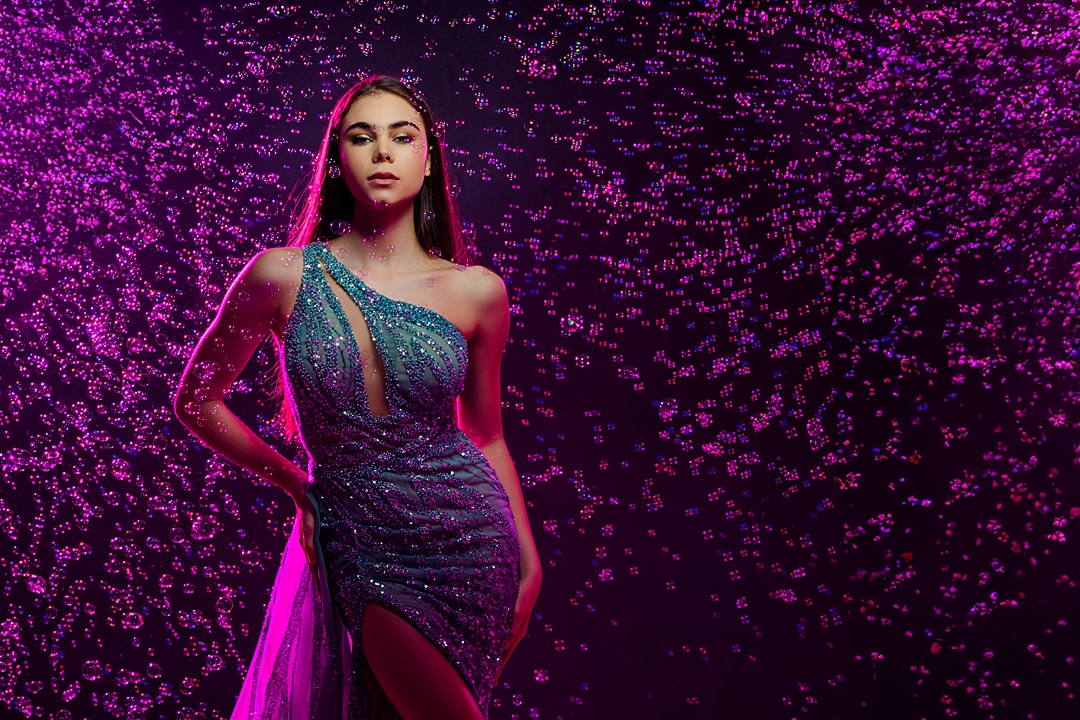
2. Pink and Lighting: A Dreamy Combination
Let’s talk lighting! Pink, when paired with creative lighting, can do wonders for your photos. In Slava’s portraits, the glowing pink light wraps around her figure, enhancing the sparkle in her dress and the mood of the image. This is where pink really shines—it creates a surreal, almost dreamy quality that pulls the viewer into the shot.
When using pink lighting, it’s all about balance. Soft pink hues can bring a sense of romance and warmth, while hot pink can energize and create drama. For instance, in the shots where bubbles surround Slava, the intense pink background creates a mesmerizing, whimsical effect that feels like she’s in a fantasy world.
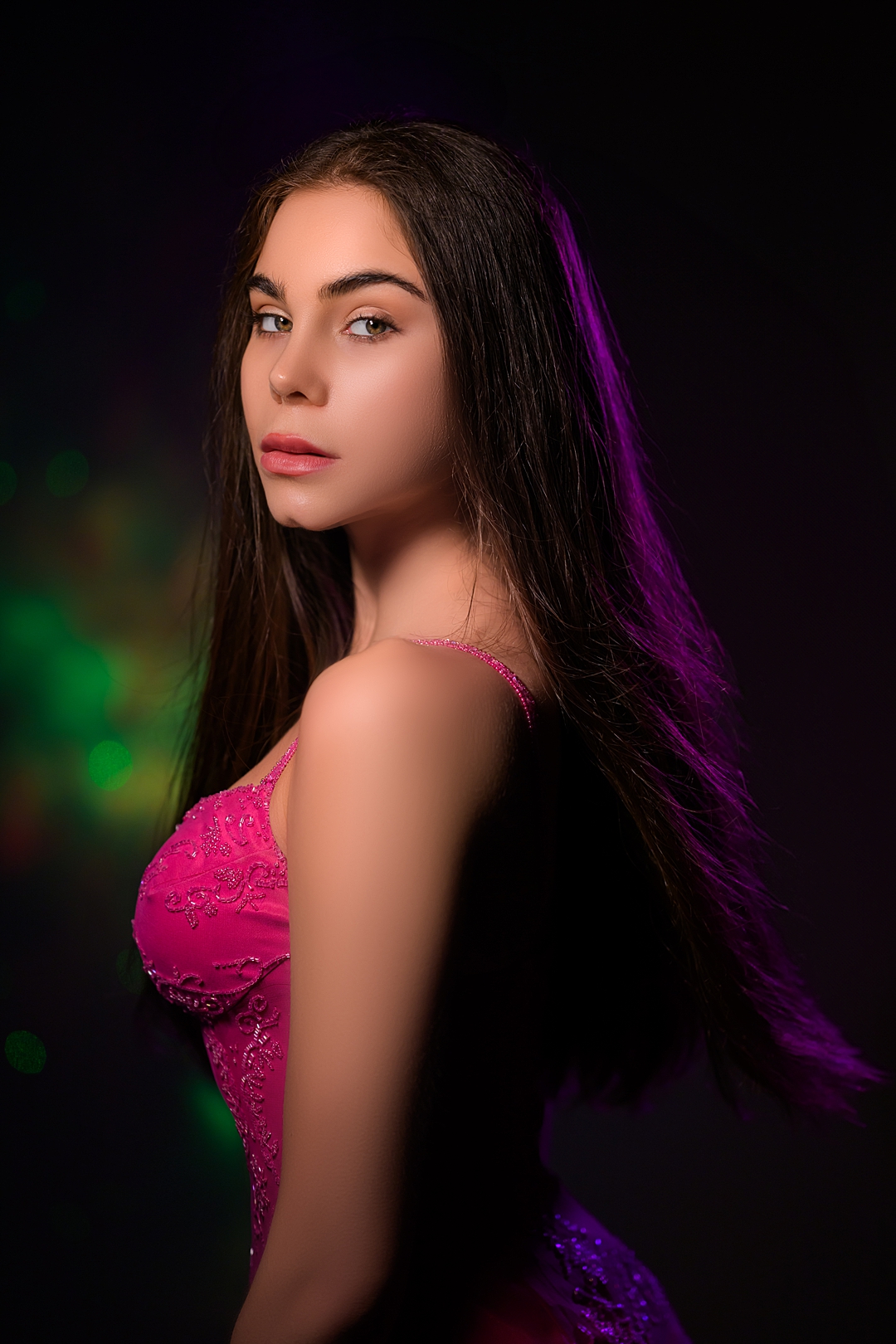
3. Wardrobe and Pink: Amplifying Glamour
Slava’s wardrobe perfectly complements the pink tones surrounding her. Whether she’s in a shimmering, glittery gown or a bold, edgy outfit, the color pink amplifies her glamorous look. Pink works great for subjects who want to feel powerful and feminine at the same time. A pink dress, especially when it’s paired with sequins or intricate detailing, can give off an ultra-luxurious vibe, making your subject look like they’re straight out of a high-fashion magazine.
Even in more casual, playful portraits—like the shot of Slava dancing—the pink lighting adds a layer of fun and sass, making the image pop with personality.
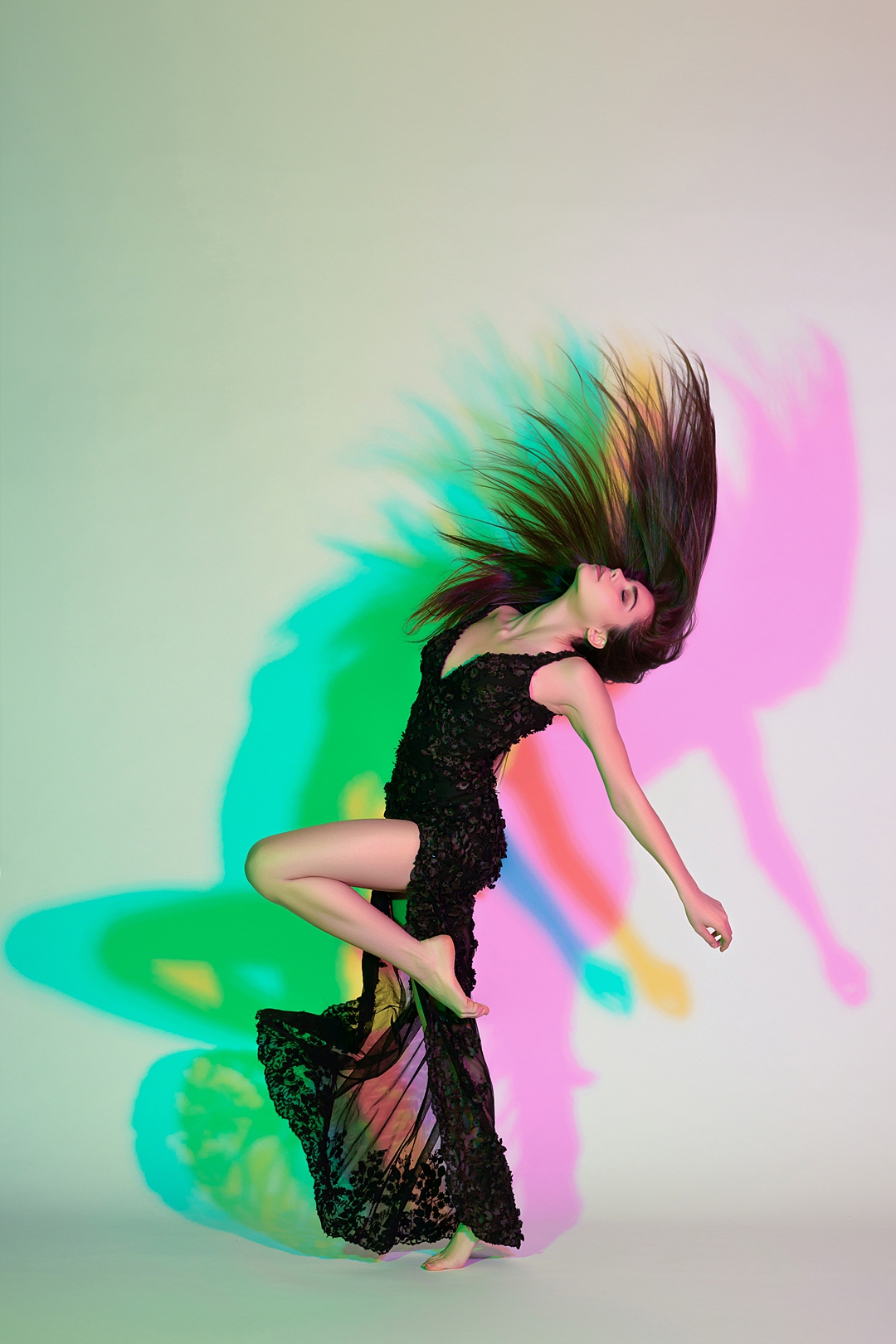
4. The Magic of Pink in Post-Processing
The beauty of pink doesn’t stop at the shoot—it can also be your secret weapon in post-processing. In Slava’s portraits, the pink tones were likely enhanced in editing to bring out that extra level of depth and mood. Adding a pink tint to highlights or shadows can make an image feel more cohesive and intentional, giving your portraits a signature look that stands out.
You can experiment with different shades of pink in post-processing to change the entire mood of your photo. A soft pink fog can add a vintage, romantic touch, while a bolder pink hue can give off a modern, edgy vibe. In this photograph in particular the fog was colored pink during the photoshoot and not added later on, but you can create a similar look in photoshop. You can see the BTS videos of all of these photos on my social media and in my course

Final Thoughts
Pink is a game-changer in portrait photography. It’s not just a color—it’s an emotion, a statement, and a visual tool that can transform your images. Whether you’re going for soft and sweet or fierce and bold, pink offers endless possibilities for creativity. And as Slava’s portraits prove, when you use pink with intention, it can create unforgettable, high-impact shots that leave a lasting impression.
So, next time you’re planning a portrait session, don’t shy away from pink—embrace its versatility, and watch your photos come to life!
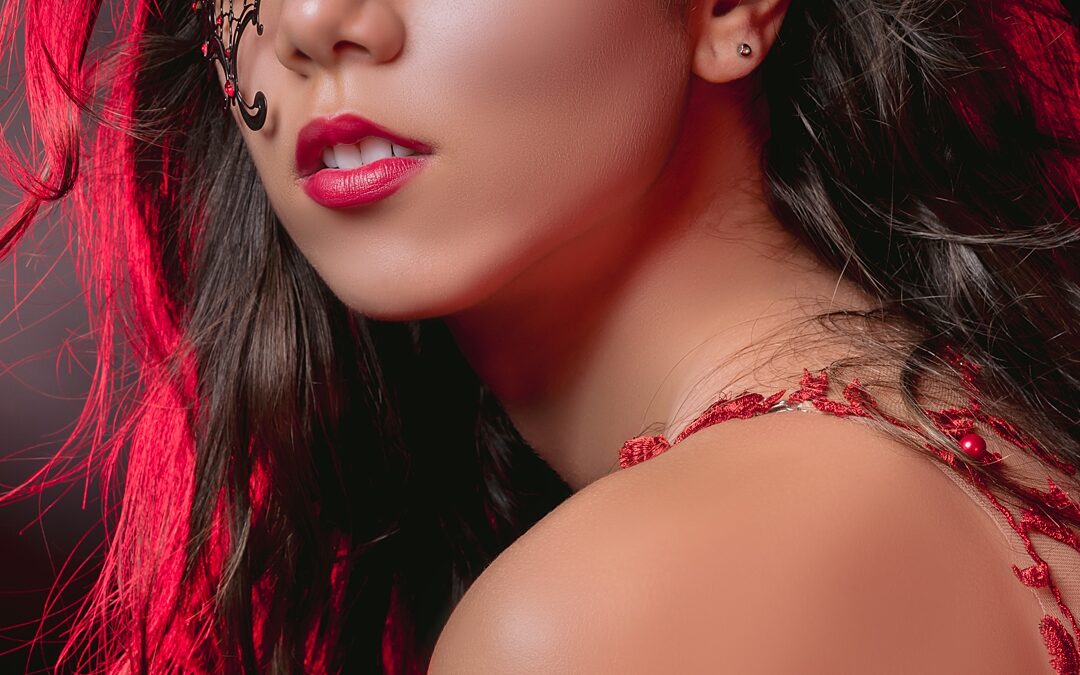
by ChristinaWehbe | Nov 20, 2024 | For Photographers
Let’s talk about red—the color that makes hearts race, eyes widen, and photos sizzle. It’s bold, it’s powerful, and it’s packed with emotion. When you’re working with red in portrait photography, you’re not just adding a splash of color; you’re creating a mood, telling a story, and tapping into some serious psychological vibes. Want to know why red packs such a punch and how to use it like a pro? Let’s dig into the science behind the color of fire, passion, and all things dramatic!
1. Red = Energy and Passion
Think about red for a second—stop signs, fast cars, and roses. It’s the color that grabs your attention and doesn’t let go! Psychologically, red triggers excitement, passion, and even a hint of danger. In portrait photography, red instantly amps up the energy in your shot. Whether it’s a killer red dress, bold lipstick, or even a red chair, this color commands the spotlight.
Why does it work so well? Because red is literally wired into our brains as a color of action! It’s the color of heightened emotions, from love to urgency, making it perfect for photos that need a little extra oomph. Want your portraits to exude power and drama? Red’s your go-to. It pulls the viewer’s eyes right in, making your subject stand out like a star.
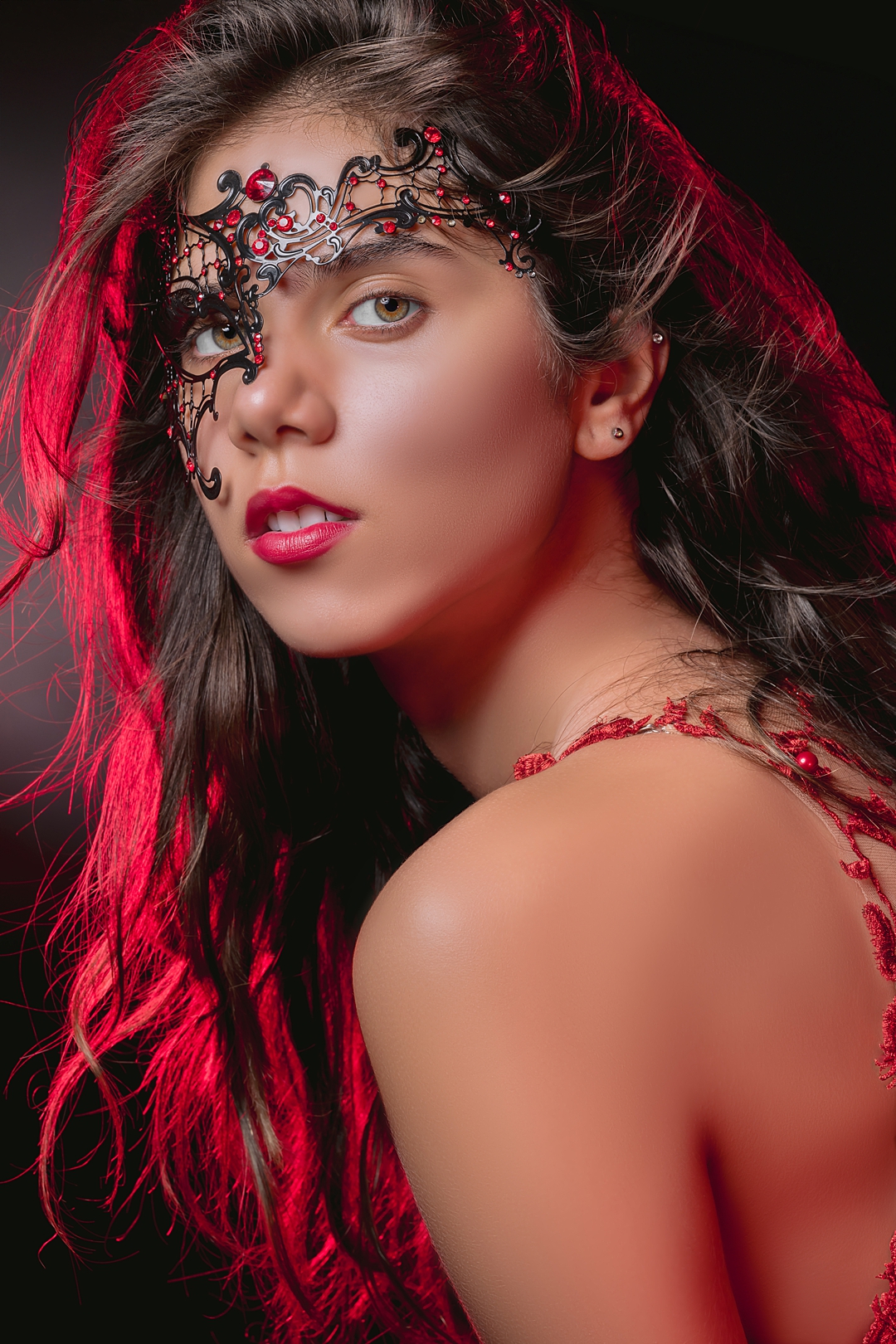
2. Red and Skin Tones: A Tricky Balance
Okay, here’s the science-y part. Red wavelengths are long, which means they reflect off surfaces (like skin) in ways that can make people look warmer—or a little too warm. If your subject has a pinkish undertone, too much red in the frame can make them look flushed or overexposed. Yikes!
Pro Tip: When working with red, balance it out with cooler tones. For instance, a crisp white or a soft grey background can keep those fiery reds in check, so your subject’s skin doesn’t turn into a tomato. The goal is to let the red pop without overwhelming the entire image. Think contrast, not overload!

3. Red in Wardrobe and Styling: The Power Move
Red is the ultimate statement-maker. In fashion, red is the “look at me” color, and in portraits, it’s no different. Whether it’s a fierce red dress, a structured red blazer, or even just a pair of red heels, your subject will radiate confidence. Bold, daring, and a little glamorous, red wardrobe choices are perfect for clients who want to stand out and make a statement.
Even if a full-on red ensemble seems like too much, adding a pop of red—whether it’s through lipstick, accessories, or shoes—can elevate the shot without overwhelming the frame. Red is confidence in color form!
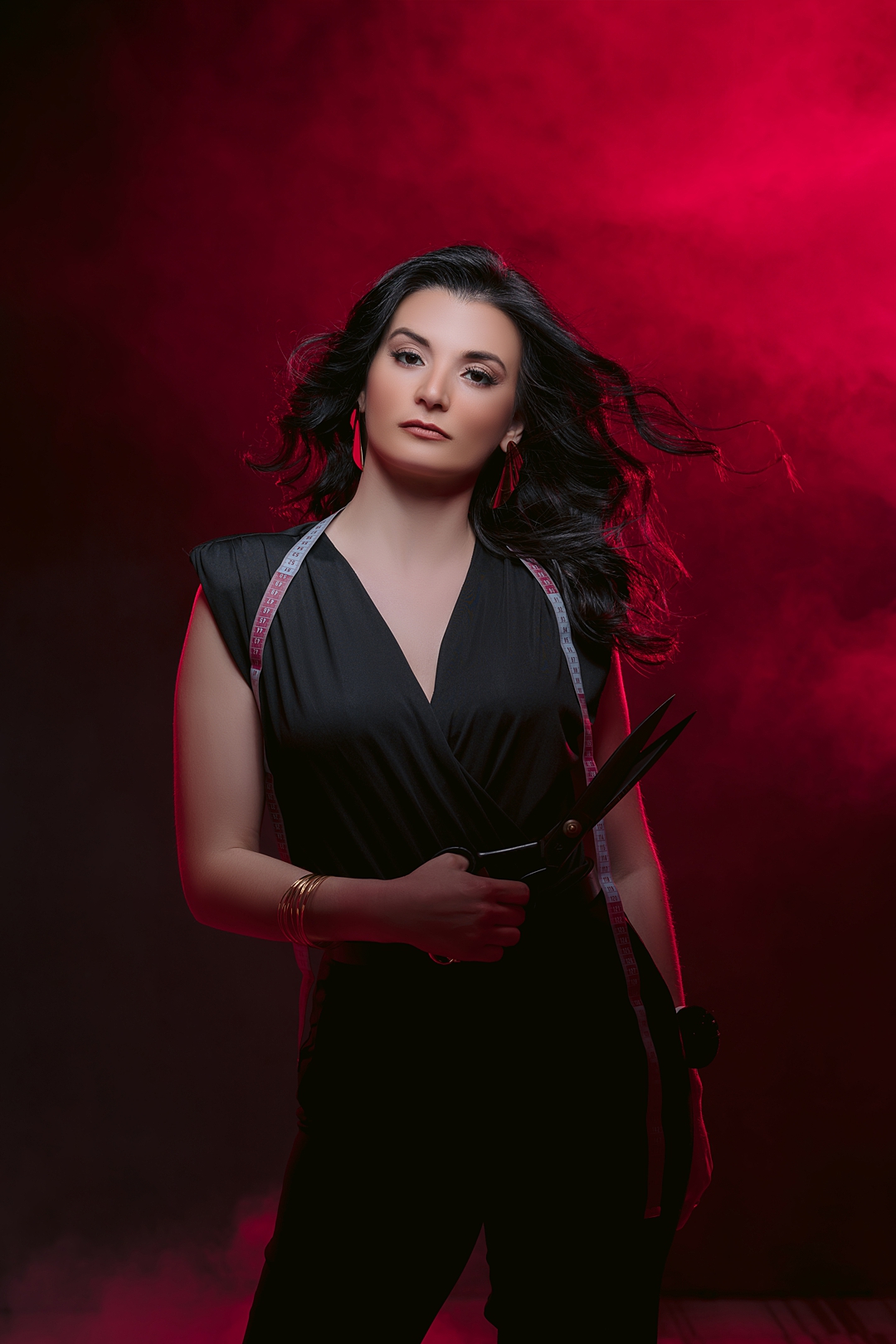
4. Red Backgrounds: Creating Depth and Drama
Using a red background can be a game-changer, but it’s a balancing act. Too much red, and the background might steal the show, leaving your subject in the shadows. The trick? Go for deeper shades like burgundy or wine-red to add a sense of depth and drama without overpowering the person in the frame.
A rich, dark red backdrop can give your portrait that moody, cinematic feel—think old Hollywood glam meets modern-day chic. It’s intense, but in all the right ways, drawing the viewer’s eyes straight to your subject and creating a captivating atmosphere.
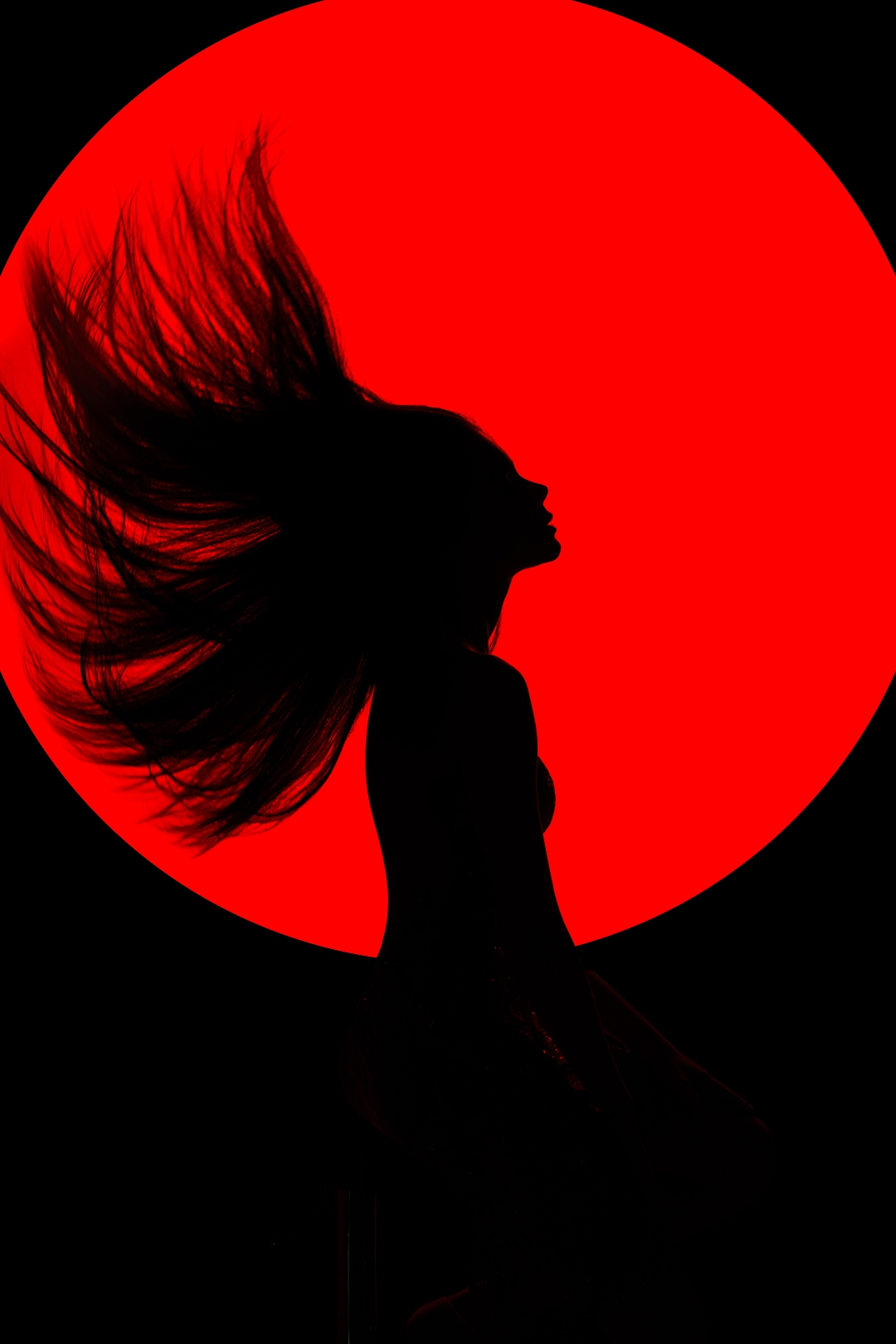
5. Red in Post-Processing: The Art of Adjusting
Red doesn’t just play nice during the shoot—it can be a game-changer in post-processing too. Want to crank up the intensity? Increase the red saturation and watch as your image goes from “nice” to “whoa!” Want something softer? Tone it down to give your reds a more romantic, vintage feel. A slight red tint in the highlights or shadows can evoke warmth, nostalgia, and even a sense of timelessness.
Red can also be used to direct attention—adjusting the tone in certain parts of the image (like shadows or highlights) can emphasize your subject’s features or create a more artistic, filmic look. Play with it, experiment, and see how red can totally transform the vibe of your portrait.
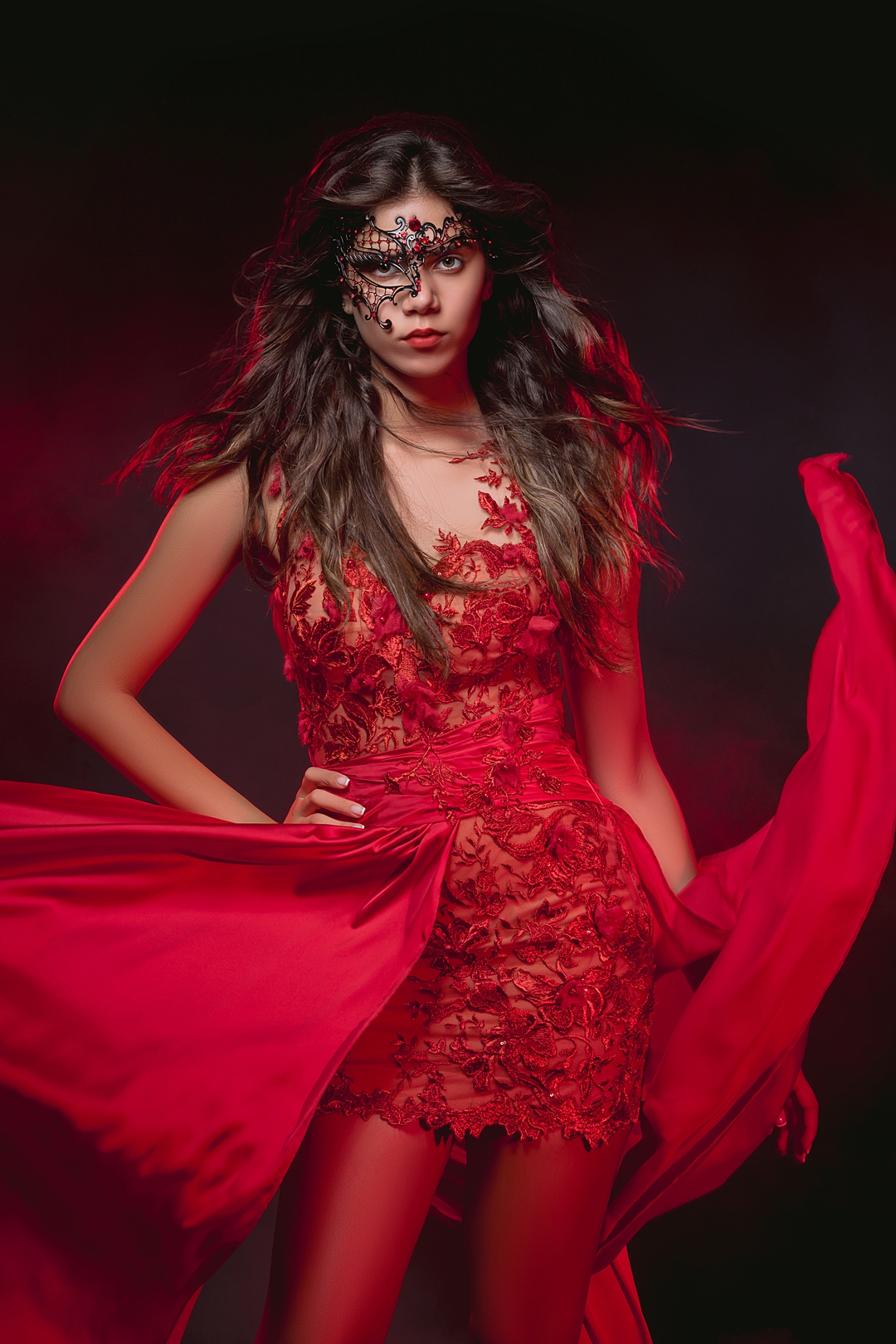
Final Thoughts
Red is like the espresso shot of colors—it’s not for the faint of heart, but when used right, it can energize and elevate your portrait photography to a whole new level. Whether it’s in the wardrobe, the background, or even in post-processing, red brings passion, power, and presence to every shot. So don’t be afraid to go bold with red—it’s the secret sauce to portraits that pack a punch!

